Comprehensive Analysis of a Three-Year-Old Child's Development
VerifiedAdded on 2023/04/04
|8
|1568
|477
Report
AI Summary
This report provides a comprehensive assessment of a three-year-old child's development, encompassing physical, cognitive, and psychosocial domains. It begins with an introduction to the subject, followed by an analysis of the child's physical attributes, including weight, height, and motor skills, comparing them to developmental milestones and Piaget's theory. The cognitive section examines numeracy, memory, and language skills, linking them to the theory of mind and apparent learning. The psychosocial development section explores the child's relationships with family and strangers, social communication, and social inhibition, drawing on Piaget's theories of classical and apparent conditioning. The report concludes with an overview of the child's strengths and areas for potential development, highlighting the importance of cognitive activeness and the absence of social inhibitions. References to supporting research are included.
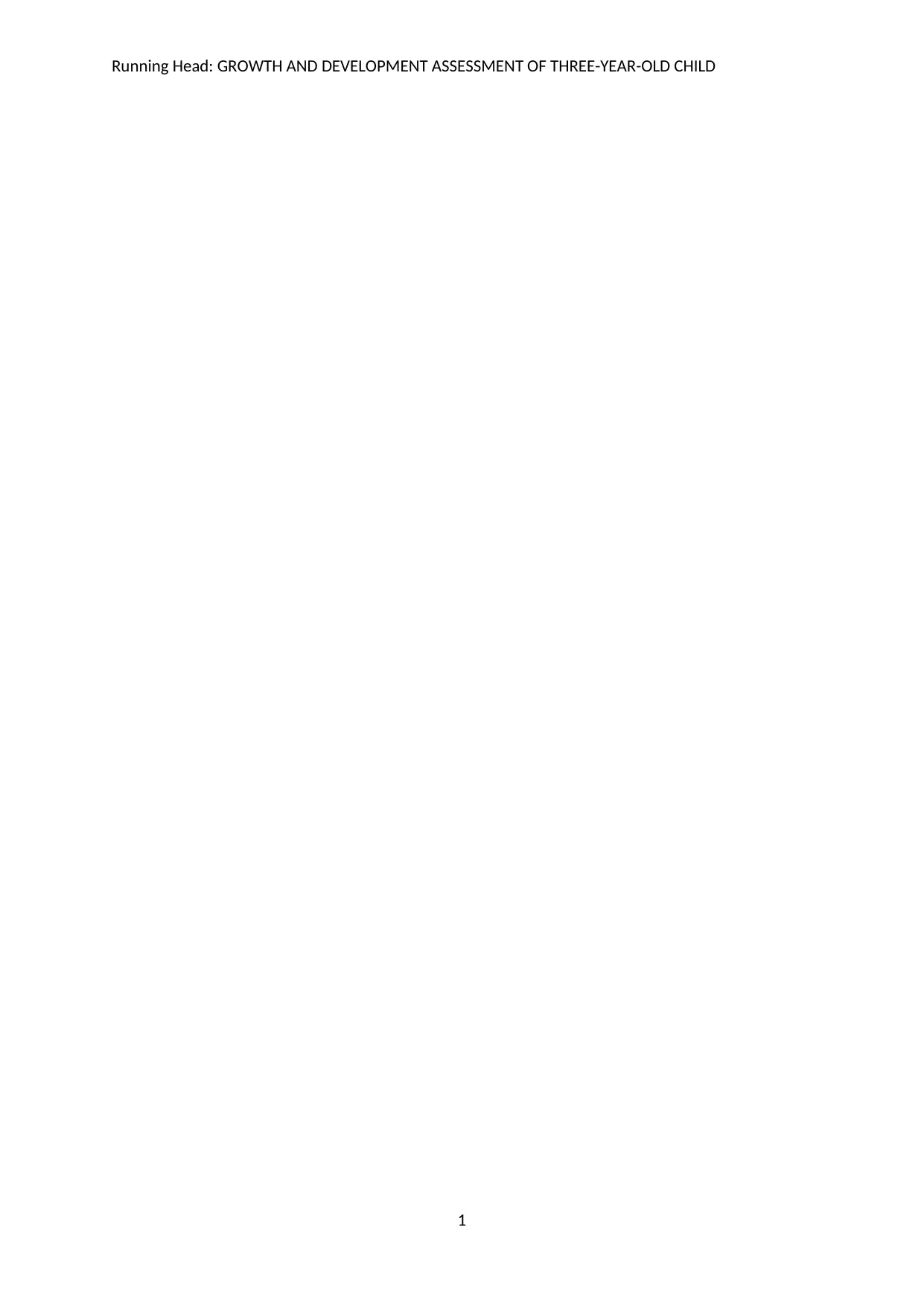
Running Head: GROWTH AND DEVELOPMENT ASSESSMENT OF THREE-YEAR-OLD CHILD
1
1
Paraphrase This Document
Need a fresh take? Get an instant paraphrase of this document with our AI Paraphraser
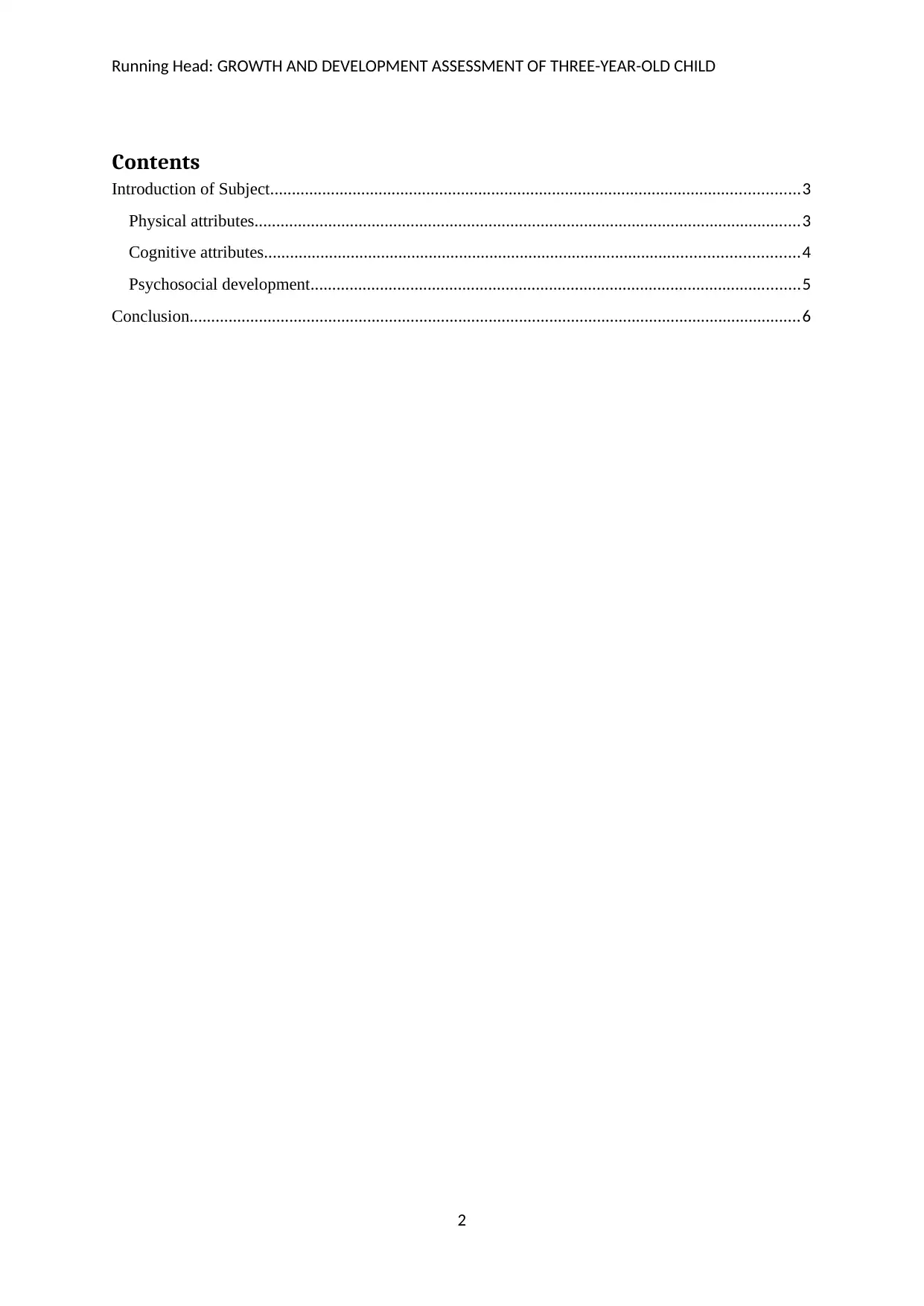
Running Head: GROWTH AND DEVELOPMENT ASSESSMENT OF THREE-YEAR-OLD CHILD
Contents
Introduction of Subject..........................................................................................................................3
Physical attributes..............................................................................................................................3
Cognitive attributes...........................................................................................................................4
Psychosocial development.................................................................................................................5
Conclusion.............................................................................................................................................6
2
Contents
Introduction of Subject..........................................................................................................................3
Physical attributes..............................................................................................................................3
Cognitive attributes...........................................................................................................................4
Psychosocial development.................................................................................................................5
Conclusion.............................................................................................................................................6
2
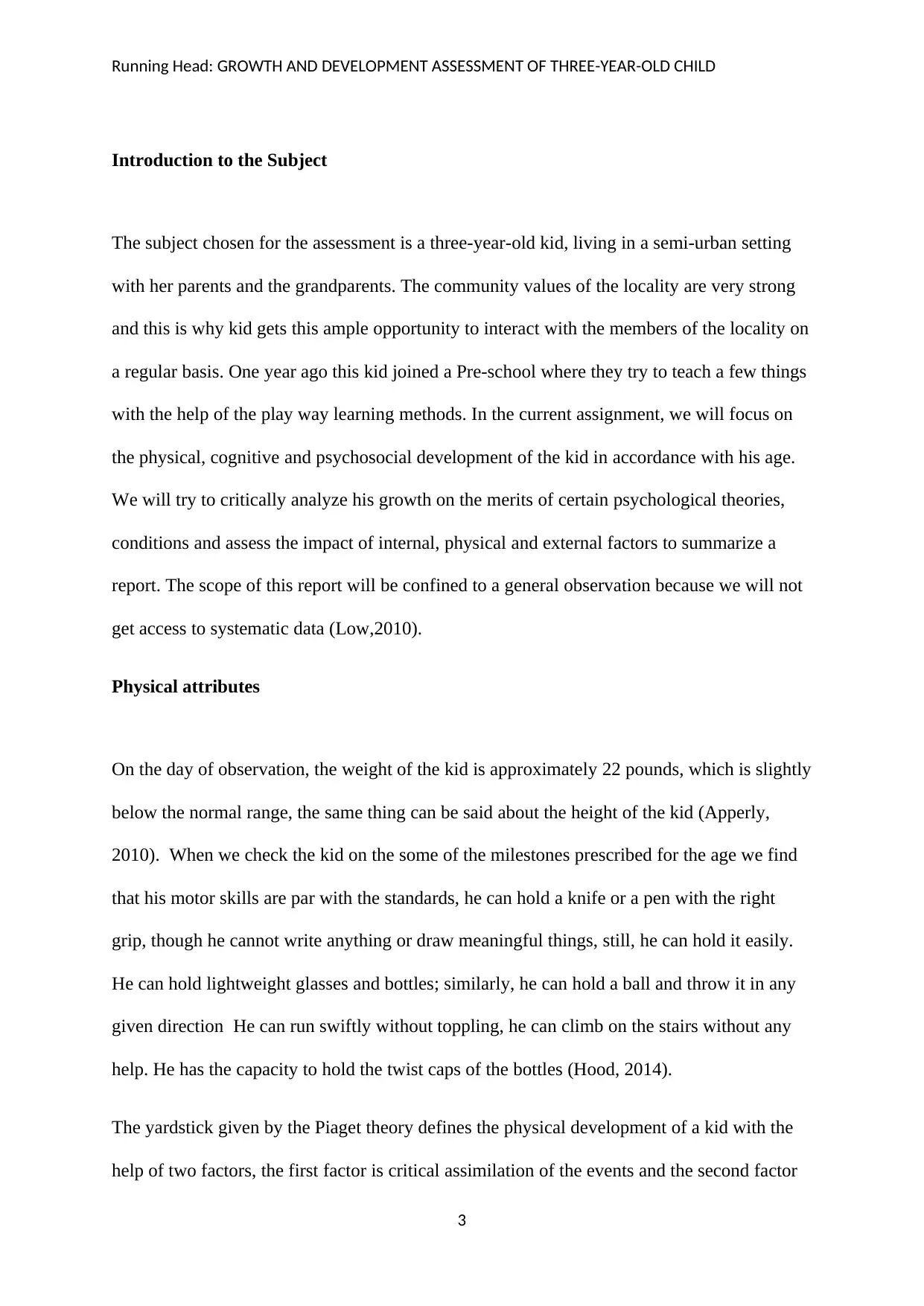
Running Head: GROWTH AND DEVELOPMENT ASSESSMENT OF THREE-YEAR-OLD CHILD
Introduction to the Subject
The subject chosen for the assessment is a three-year-old kid, living in a semi-urban setting
with her parents and the grandparents. The community values of the locality are very strong
and this is why kid gets this ample opportunity to interact with the members of the locality on
a regular basis. One year ago this kid joined a Pre-school where they try to teach a few things
with the help of the play way learning methods. In the current assignment, we will focus on
the physical, cognitive and psychosocial development of the kid in accordance with his age.
We will try to critically analyze his growth on the merits of certain psychological theories,
conditions and assess the impact of internal, physical and external factors to summarize a
report. The scope of this report will be confined to a general observation because we will not
get access to systematic data (Low,2010).
Physical attributes
On the day of observation, the weight of the kid is approximately 22 pounds, which is slightly
below the normal range, the same thing can be said about the height of the kid (Apperly,
2010). When we check the kid on the some of the milestones prescribed for the age we find
that his motor skills are par with the standards, he can hold a knife or a pen with the right
grip, though he cannot write anything or draw meaningful things, still, he can hold it easily.
He can hold lightweight glasses and bottles; similarly, he can hold a ball and throw it in any
given direction He can run swiftly without toppling, he can climb on the stairs without any
help. He has the capacity to hold the twist caps of the bottles (Hood, 2014).
The yardstick given by the Piaget theory defines the physical development of a kid with the
help of two factors, the first factor is critical assimilation of the events and the second factor
3
Introduction to the Subject
The subject chosen for the assessment is a three-year-old kid, living in a semi-urban setting
with her parents and the grandparents. The community values of the locality are very strong
and this is why kid gets this ample opportunity to interact with the members of the locality on
a regular basis. One year ago this kid joined a Pre-school where they try to teach a few things
with the help of the play way learning methods. In the current assignment, we will focus on
the physical, cognitive and psychosocial development of the kid in accordance with his age.
We will try to critically analyze his growth on the merits of certain psychological theories,
conditions and assess the impact of internal, physical and external factors to summarize a
report. The scope of this report will be confined to a general observation because we will not
get access to systematic data (Low,2010).
Physical attributes
On the day of observation, the weight of the kid is approximately 22 pounds, which is slightly
below the normal range, the same thing can be said about the height of the kid (Apperly,
2010). When we check the kid on the some of the milestones prescribed for the age we find
that his motor skills are par with the standards, he can hold a knife or a pen with the right
grip, though he cannot write anything or draw meaningful things, still, he can hold it easily.
He can hold lightweight glasses and bottles; similarly, he can hold a ball and throw it in any
given direction He can run swiftly without toppling, he can climb on the stairs without any
help. He has the capacity to hold the twist caps of the bottles (Hood, 2014).
The yardstick given by the Piaget theory defines the physical development of a kid with the
help of two factors, the first factor is critical assimilation of the events and the second factor
3
⊘ This is a preview!⊘
Do you want full access?
Subscribe today to unlock all pages.

Trusted by 1+ million students worldwide
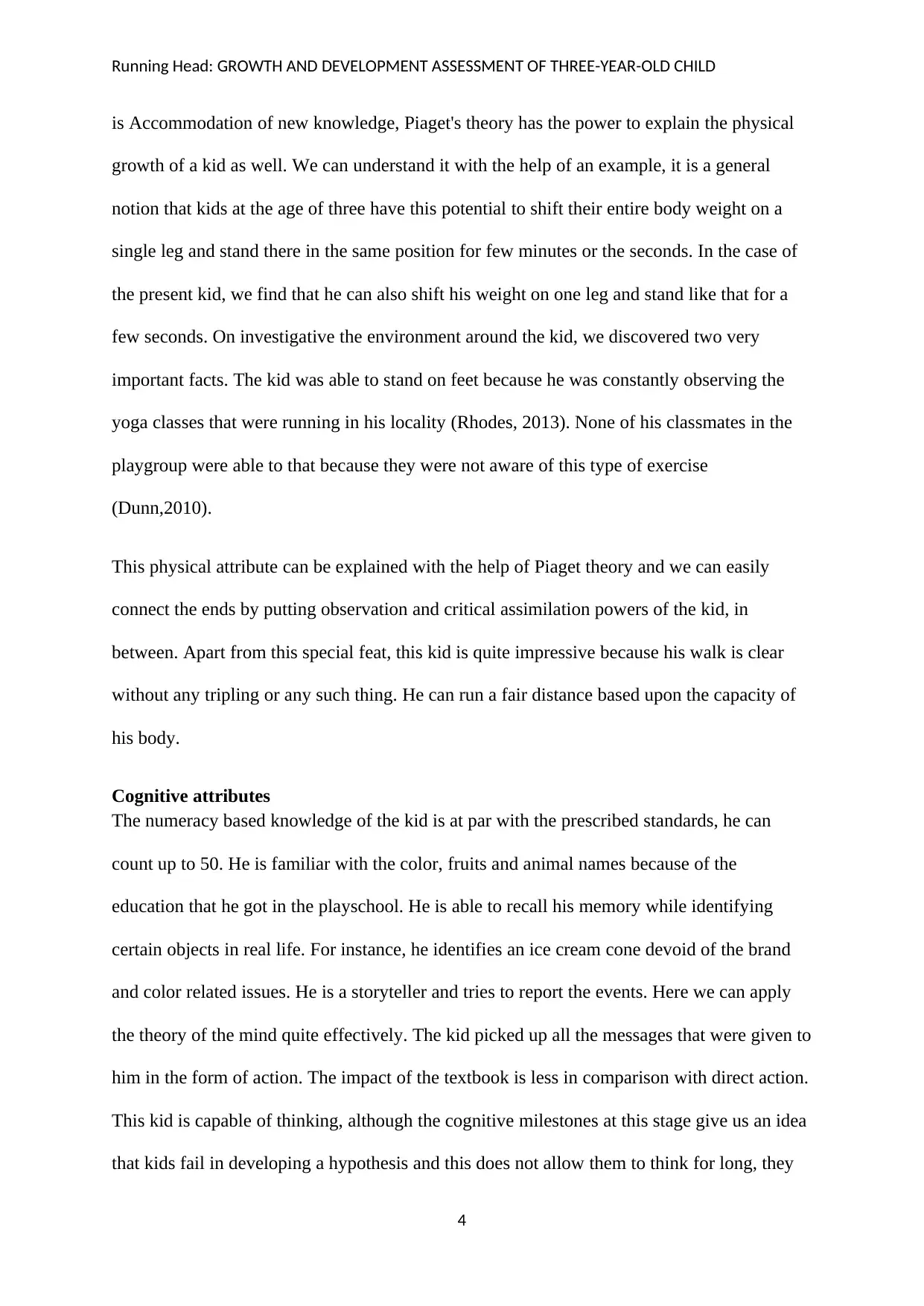
Running Head: GROWTH AND DEVELOPMENT ASSESSMENT OF THREE-YEAR-OLD CHILD
is Accommodation of new knowledge, Piaget's theory has the power to explain the physical
growth of a kid as well. We can understand it with the help of an example, it is a general
notion that kids at the age of three have this potential to shift their entire body weight on a
single leg and stand there in the same position for few minutes or the seconds. In the case of
the present kid, we find that he can also shift his weight on one leg and stand like that for a
few seconds. On investigative the environment around the kid, we discovered two very
important facts. The kid was able to stand on feet because he was constantly observing the
yoga classes that were running in his locality (Rhodes, 2013). None of his classmates in the
playgroup were able to that because they were not aware of this type of exercise
(Dunn,2010).
This physical attribute can be explained with the help of Piaget theory and we can easily
connect the ends by putting observation and critical assimilation powers of the kid, in
between. Apart from this special feat, this kid is quite impressive because his walk is clear
without any tripling or any such thing. He can run a fair distance based upon the capacity of
his body.
Cognitive attributes
The numeracy based knowledge of the kid is at par with the prescribed standards, he can
count up to 50. He is familiar with the color, fruits and animal names because of the
education that he got in the playschool. He is able to recall his memory while identifying
certain objects in real life. For instance, he identifies an ice cream cone devoid of the brand
and color related issues. He is a storyteller and tries to report the events. Here we can apply
the theory of the mind quite effectively. The kid picked up all the messages that were given to
him in the form of action. The impact of the textbook is less in comparison with direct action.
This kid is capable of thinking, although the cognitive milestones at this stage give us an idea
that kids fail in developing a hypothesis and this does not allow them to think for long, they
4
is Accommodation of new knowledge, Piaget's theory has the power to explain the physical
growth of a kid as well. We can understand it with the help of an example, it is a general
notion that kids at the age of three have this potential to shift their entire body weight on a
single leg and stand there in the same position for few minutes or the seconds. In the case of
the present kid, we find that he can also shift his weight on one leg and stand like that for a
few seconds. On investigative the environment around the kid, we discovered two very
important facts. The kid was able to stand on feet because he was constantly observing the
yoga classes that were running in his locality (Rhodes, 2013). None of his classmates in the
playgroup were able to that because they were not aware of this type of exercise
(Dunn,2010).
This physical attribute can be explained with the help of Piaget theory and we can easily
connect the ends by putting observation and critical assimilation powers of the kid, in
between. Apart from this special feat, this kid is quite impressive because his walk is clear
without any tripling or any such thing. He can run a fair distance based upon the capacity of
his body.
Cognitive attributes
The numeracy based knowledge of the kid is at par with the prescribed standards, he can
count up to 50. He is familiar with the color, fruits and animal names because of the
education that he got in the playschool. He is able to recall his memory while identifying
certain objects in real life. For instance, he identifies an ice cream cone devoid of the brand
and color related issues. He is a storyteller and tries to report the events. Here we can apply
the theory of the mind quite effectively. The kid picked up all the messages that were given to
him in the form of action. The impact of the textbook is less in comparison with direct action.
This kid is capable of thinking, although the cognitive milestones at this stage give us an idea
that kids fail in developing a hypothesis and this does not allow them to think for long, they
4
Paraphrase This Document
Need a fresh take? Get an instant paraphrase of this document with our AI Paraphraser

Running Head: GROWTH AND DEVELOPMENT ASSESSMENT OF THREE-YEAR-OLD CHILD
need some support, we can also define it with the help of apparent learning. At the age of
three many kids fail in developing an apparent learning framework. They need behavioral
intervention to learn, or we can say that they learn it in the hardest way. This is not the case
with this kid; his apparent learning faculty is in place because of his language skills
(Bolz,2012). These language skills allow him to speak some unclear words. Minute
observation of his chats gives us an idea that he is capable of grasping the sound and
pronunciation of the words, however, he is not able to reproduce all of them because of the
limitation caused by the development of the tongue and speech faculty (Gopnik,2012).
Psychosocial development
This kid identifies his biological families; he is very close to the individuals that share a
familial space with him. He also identifies the strangers and finds himself uncomfortable in
their company (Graham, 2010). At a social level, he is capable of communicating with
broken sentences and he is quite capable of expressing short commands (Buttelmann, 2010).
The findings of the Piaget theory gives us an idea that the kid is learning a few things with
the help of classical conditioning, sometimes he also learns a few things with the help of
apparent conditioning as well. In order to develop a better understanding of the psychosocial
developments we should study the social setups where he is moving, this kid is doing good
with his peers and with the help of a half-developed linguistic faculty he can communicate
about his needs and the activities that he is enjoying (Baron, 2013).
In order to understand the psychosocial development of this kid, we can also take the support
of the theories related to social inhibition. In the case of the current kid, we can see that social
inhibition is at the minimum level. The theories of the Piaget here give us an idea that
problems like social inhibition can act as a big problem in the life of an adult as well
(Baillergeon, 2010).
5
need some support, we can also define it with the help of apparent learning. At the age of
three many kids fail in developing an apparent learning framework. They need behavioral
intervention to learn, or we can say that they learn it in the hardest way. This is not the case
with this kid; his apparent learning faculty is in place because of his language skills
(Bolz,2012). These language skills allow him to speak some unclear words. Minute
observation of his chats gives us an idea that he is capable of grasping the sound and
pronunciation of the words, however, he is not able to reproduce all of them because of the
limitation caused by the development of the tongue and speech faculty (Gopnik,2012).
Psychosocial development
This kid identifies his biological families; he is very close to the individuals that share a
familial space with him. He also identifies the strangers and finds himself uncomfortable in
their company (Graham, 2010). At a social level, he is capable of communicating with
broken sentences and he is quite capable of expressing short commands (Buttelmann, 2010).
The findings of the Piaget theory gives us an idea that the kid is learning a few things with
the help of classical conditioning, sometimes he also learns a few things with the help of
apparent conditioning as well. In order to develop a better understanding of the psychosocial
developments we should study the social setups where he is moving, this kid is doing good
with his peers and with the help of a half-developed linguistic faculty he can communicate
about his needs and the activities that he is enjoying (Baron, 2013).
In order to understand the psychosocial development of this kid, we can also take the support
of the theories related to social inhibition. In the case of the current kid, we can see that social
inhibition is at the minimum level. The theories of the Piaget here give us an idea that
problems like social inhibition can act as a big problem in the life of an adult as well
(Baillergeon, 2010).
5
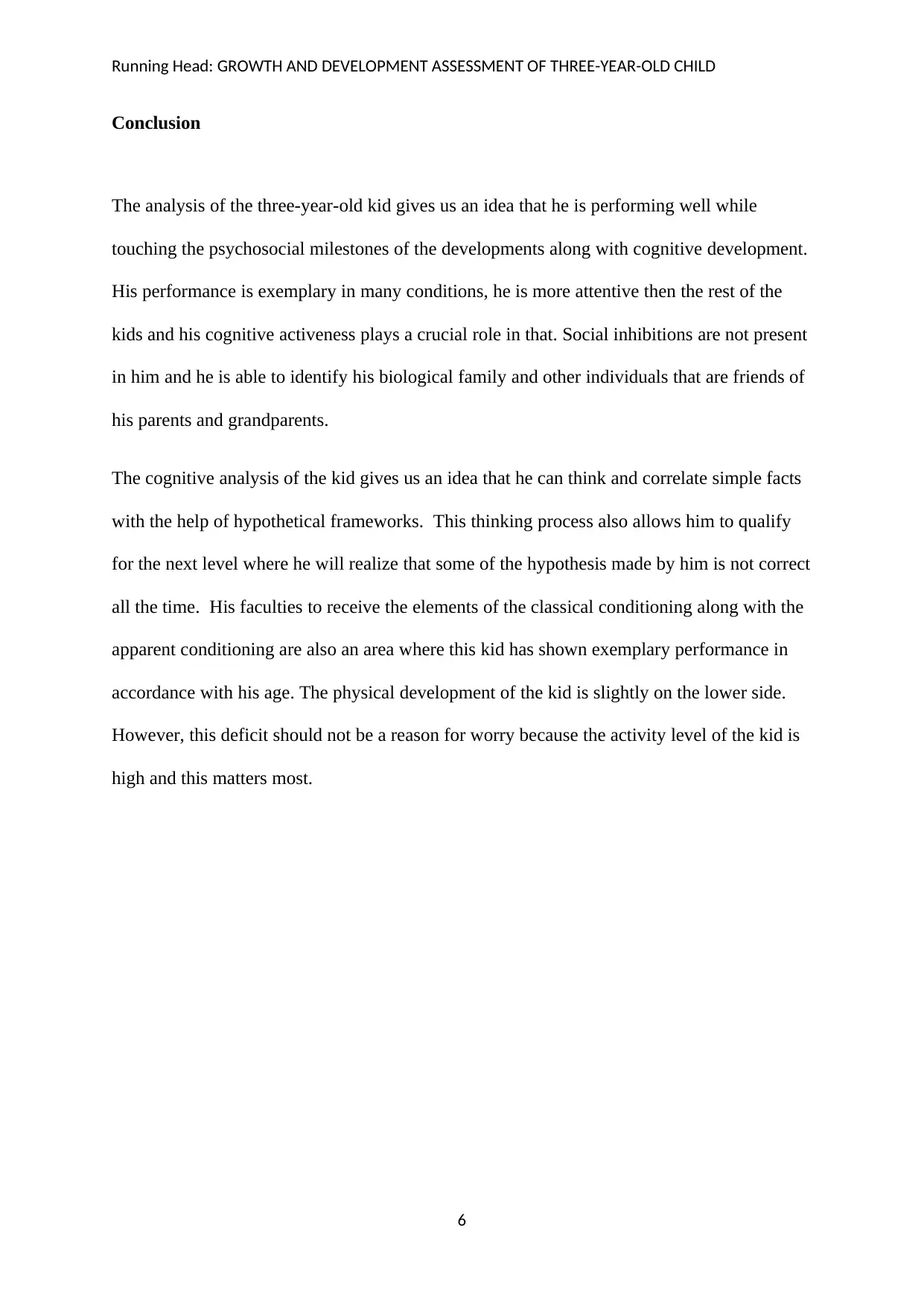
Running Head: GROWTH AND DEVELOPMENT ASSESSMENT OF THREE-YEAR-OLD CHILD
Conclusion
The analysis of the three-year-old kid gives us an idea that he is performing well while
touching the psychosocial milestones of the developments along with cognitive development.
His performance is exemplary in many conditions, he is more attentive then the rest of the
kids and his cognitive activeness plays a crucial role in that. Social inhibitions are not present
in him and he is able to identify his biological family and other individuals that are friends of
his parents and grandparents.
The cognitive analysis of the kid gives us an idea that he can think and correlate simple facts
with the help of hypothetical frameworks. This thinking process also allows him to qualify
for the next level where he will realize that some of the hypothesis made by him is not correct
all the time. His faculties to receive the elements of the classical conditioning along with the
apparent conditioning are also an area where this kid has shown exemplary performance in
accordance with his age. The physical development of the kid is slightly on the lower side.
However, this deficit should not be a reason for worry because the activity level of the kid is
high and this matters most.
6
Conclusion
The analysis of the three-year-old kid gives us an idea that he is performing well while
touching the psychosocial milestones of the developments along with cognitive development.
His performance is exemplary in many conditions, he is more attentive then the rest of the
kids and his cognitive activeness plays a crucial role in that. Social inhibitions are not present
in him and he is able to identify his biological family and other individuals that are friends of
his parents and grandparents.
The cognitive analysis of the kid gives us an idea that he can think and correlate simple facts
with the help of hypothetical frameworks. This thinking process also allows him to qualify
for the next level where he will realize that some of the hypothesis made by him is not correct
all the time. His faculties to receive the elements of the classical conditioning along with the
apparent conditioning are also an area where this kid has shown exemplary performance in
accordance with his age. The physical development of the kid is slightly on the lower side.
However, this deficit should not be a reason for worry because the activity level of the kid is
high and this matters most.
6
⊘ This is a preview!⊘
Do you want full access?
Subscribe today to unlock all pages.

Trusted by 1+ million students worldwide
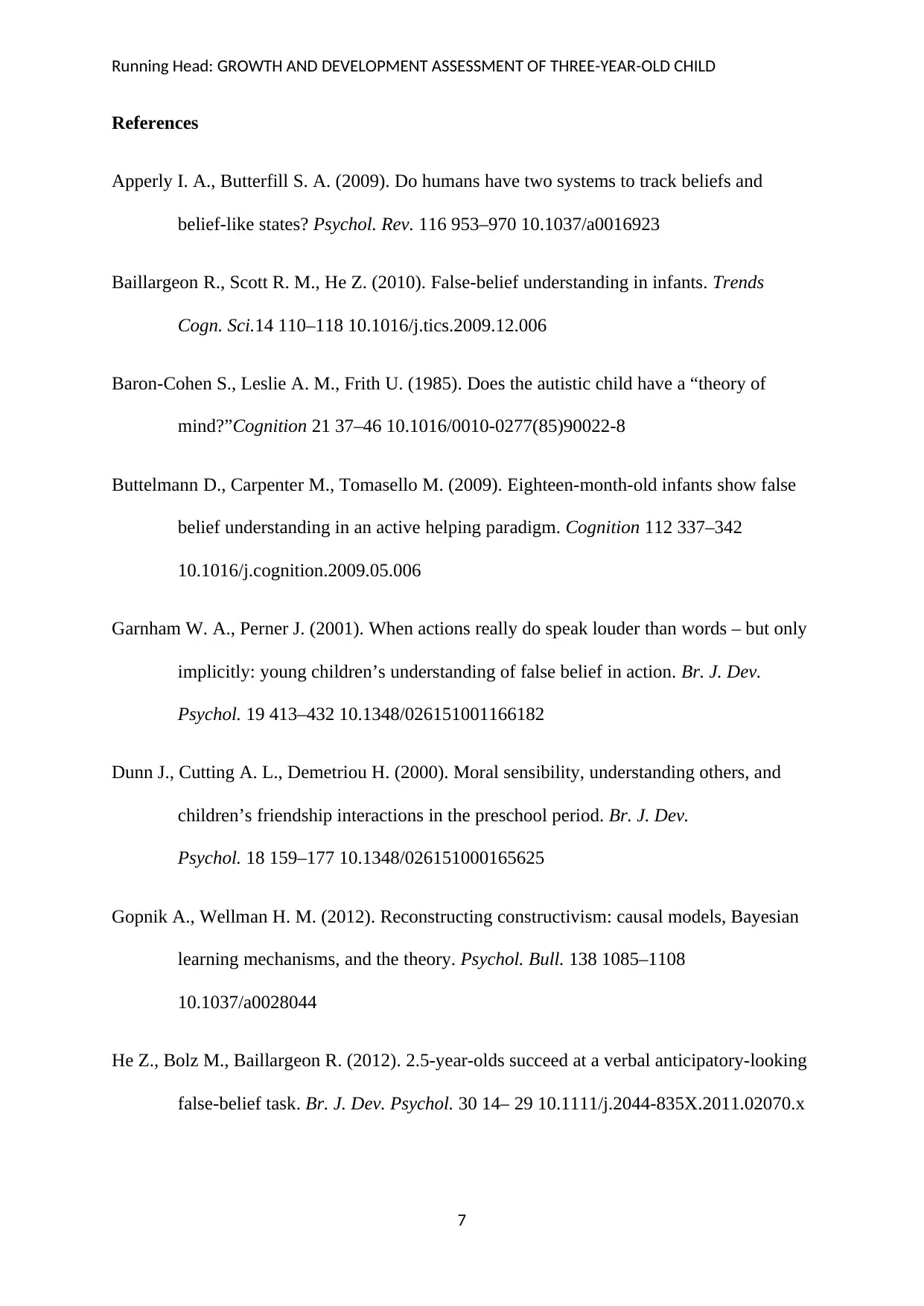
Running Head: GROWTH AND DEVELOPMENT ASSESSMENT OF THREE-YEAR-OLD CHILD
References
Apperly I. A., Butterfill S. A. (2009). Do humans have two systems to track beliefs and
belief-like states? Psychol. Rev. 116 953–970 10.1037/a0016923
Baillargeon R., Scott R. M., He Z. (2010). False-belief understanding in infants. Trends
Cogn. Sci.14 110–118 10.1016/j.tics.2009.12.006
Baron-Cohen S., Leslie A. M., Frith U. (1985). Does the autistic child have a “theory of
mind?”Cognition 21 37–46 10.1016/0010-0277(85)90022-8
Buttelmann D., Carpenter M., Tomasello M. (2009). Eighteen-month-old infants show false
belief understanding in an active helping paradigm. Cognition 112 337–342
10.1016/j.cognition.2009.05.006
Garnham W. A., Perner J. (2001). When actions really do speak louder than words – but only
implicitly: young children’s understanding of false belief in action. Br. J. Dev.
Psychol. 19 413–432 10.1348/026151001166182
Dunn J., Cutting A. L., Demetriou H. (2000). Moral sensibility, understanding others, and
children’s friendship interactions in the preschool period. Br. J. Dev.
Psychol. 18 159–177 10.1348/026151000165625
Gopnik A., Wellman H. M. (2012). Reconstructing constructivism: causal models, Bayesian
learning mechanisms, and the theory. Psychol. Bull. 138 1085–1108
10.1037/a0028044
He Z., Bolz M., Baillargeon R. (2012). 2.5-year-olds succeed at a verbal anticipatory-looking
false-belief task. Br. J. Dev. Psychol. 30 14– 29 10.1111/j.2044-835X.2011.02070.x
7
References
Apperly I. A., Butterfill S. A. (2009). Do humans have two systems to track beliefs and
belief-like states? Psychol. Rev. 116 953–970 10.1037/a0016923
Baillargeon R., Scott R. M., He Z. (2010). False-belief understanding in infants. Trends
Cogn. Sci.14 110–118 10.1016/j.tics.2009.12.006
Baron-Cohen S., Leslie A. M., Frith U. (1985). Does the autistic child have a “theory of
mind?”Cognition 21 37–46 10.1016/0010-0277(85)90022-8
Buttelmann D., Carpenter M., Tomasello M. (2009). Eighteen-month-old infants show false
belief understanding in an active helping paradigm. Cognition 112 337–342
10.1016/j.cognition.2009.05.006
Garnham W. A., Perner J. (2001). When actions really do speak louder than words – but only
implicitly: young children’s understanding of false belief in action. Br. J. Dev.
Psychol. 19 413–432 10.1348/026151001166182
Dunn J., Cutting A. L., Demetriou H. (2000). Moral sensibility, understanding others, and
children’s friendship interactions in the preschool period. Br. J. Dev.
Psychol. 18 159–177 10.1348/026151000165625
Gopnik A., Wellman H. M. (2012). Reconstructing constructivism: causal models, Bayesian
learning mechanisms, and the theory. Psychol. Bull. 138 1085–1108
10.1037/a0028044
He Z., Bolz M., Baillargeon R. (2012). 2.5-year-olds succeed at a verbal anticipatory-looking
false-belief task. Br. J. Dev. Psychol. 30 14– 29 10.1111/j.2044-835X.2011.02070.x
7
Paraphrase This Document
Need a fresh take? Get an instant paraphrase of this document with our AI Paraphraser
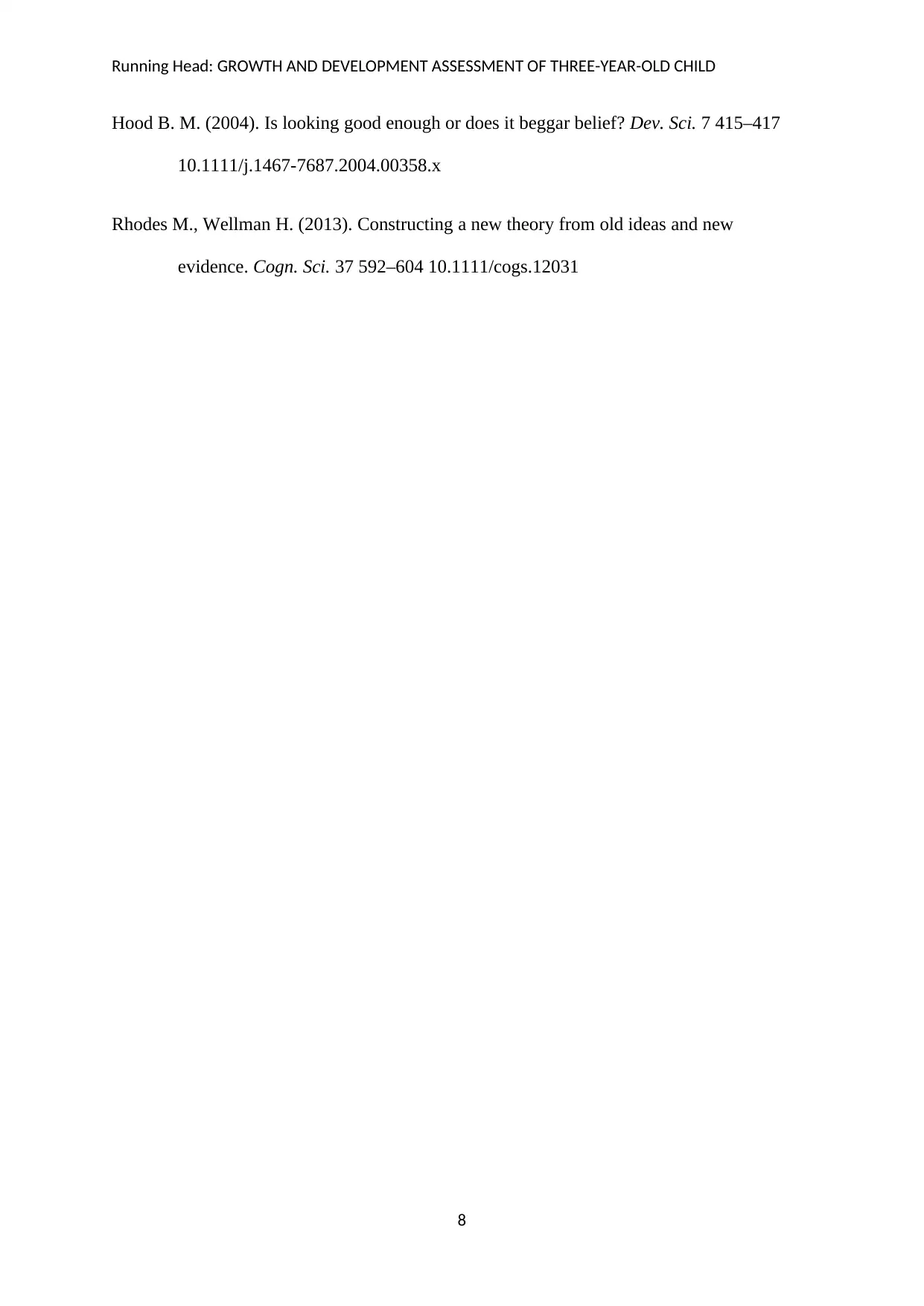
Running Head: GROWTH AND DEVELOPMENT ASSESSMENT OF THREE-YEAR-OLD CHILD
Hood B. M. (2004). Is looking good enough or does it beggar belief? Dev. Sci. 7 415–417
10.1111/j.1467-7687.2004.00358.x
Rhodes M., Wellman H. (2013). Constructing a new theory from old ideas and new
evidence. Cogn. Sci. 37 592–604 10.1111/cogs.12031
8
Hood B. M. (2004). Is looking good enough or does it beggar belief? Dev. Sci. 7 415–417
10.1111/j.1467-7687.2004.00358.x
Rhodes M., Wellman H. (2013). Constructing a new theory from old ideas and new
evidence. Cogn. Sci. 37 592–604 10.1111/cogs.12031
8
1 out of 8
Related Documents
Your All-in-One AI-Powered Toolkit for Academic Success.
+13062052269
info@desklib.com
Available 24*7 on WhatsApp / Email
![[object Object]](/_next/static/media/star-bottom.7253800d.svg)
Unlock your academic potential
Copyright © 2020–2025 A2Z Services. All Rights Reserved. Developed and managed by ZUCOL.





